Achievements of the Archaeological Research on the Silla Tumuli in Jjoksaem District, Gyeong ju
DAEHONG Jeong
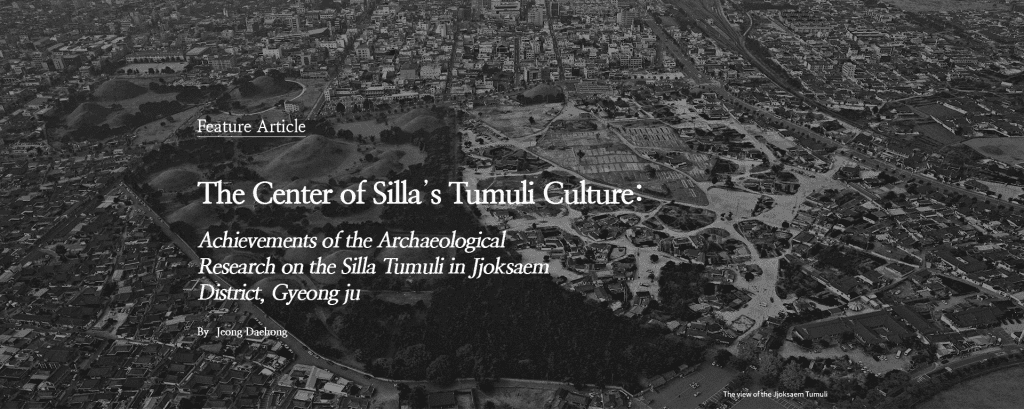

Since 2007, the Gyeongju National Research Institute of Cultural Heritage (GNRICH) has been conducting excavations and research on the Silla Tumuli in Jjoksaem District, Gyeongju. Through these efforts, the institute has identified archaeological traces of Unified Silla and Goryeo, thereby confirming that the area has long been used for a variety of different purposes. Moreover, new evidence suggests that Silla society managed their tumuli on an ongoing basis and conductedancestral rituals there. Moving forward, the GNRICH will continue to analyze new data and establish an associated database, to ensure their application in other related projects.The Silla Tumuli in Jjoksaem District, GyeongjuThe Tumuli in Jjoksaem District, Gyeongju is a cluster of tombs built between the 4th and 6th century for royal capital residents of Silla. Originally, the Jjoksaem site was part of the Daereungwon Ancient Tomb Complex, Gyeongju, a location well known for housing the Cheonmachong Tomb and Hwangnamdaechong Tomb. The Jjoksaem site has several wooden chamber tombs covered by stone and earthen mound, built during the Maripgan period of Silla, while Wolseong Palace is located nearby to the south. For these reasons, the site has been the subject of great interest among Silla tumuli researchers. In 2011, in recognition of their historical value, the Silla Tumuli in Jjoksaem District, Gyeongju, together with other tombs in the Daereungwon Ancient Tomb Complex, were designated as Historic Site No. 512.
Archaeological surveys of these tumuli and other remains in the Daereungwon Ancient Tomb Complex were initially conducted by Japanese experts even before the Japanese colonial period (1910-1945). First, surveys of ancient tombs in Hwangnam-dong were led by Imanishi Ryu in 1906 and then by Sekino Tadashi in 1909. Subsequently, basic archaeological research on Geomchong Tomb and other Silla tumuli were conducted again in 1911, under the supervision of Sekino Tadashi and Yatsui Seiichi. In 1921,the accidental discovery of a partial golden crown led to an archaeological excavation that uncovered Geumgwanchong Tomb (Tomb of the Golden Crown). These findings gave rise to the suspicion that ancient tumuli in downtown Gyeongju contained ornate golden artifacts as part of their burial goods, which, in turn, resulted in excavations of Geumnyeongchong Tomb, Singnichong Tomb, and Seobongchong Tomb. It was at this time that Silla tumuli were issued serial numbers by Nomori Ken. During the 1930s, archaeological surveys continued on numerous tombs, including Hwangnam-dong Tomb Nos. 82, 83, and 109 as well as Hwango-dong Tomb No. 54. However, after the Second Sino-Japanese War (1937-1945) and the Pacific War (1941-1945) broke out, all Japanese-led excavations on Silla tumuli came to a halt.
In 1946, after Korea’s liberation, the National Museum of Korea conducted the nation’s first archaeological excavation of Houchong Tomb. Between the 1950s and the 1960s, surveys of Silla tumuli were conducted sporadically by university museums. In 1973, with the establishment of the Gyeongju Comprehensive Tourism Development Plan, excavations on Cheonmachong Tomb and Hwangnamdaechong Tomb began, and the area was transformed into a tumuli park known as the Daereungwon Tomb Complex for large-scale preservation.
However, the adjacent Jjoksaem site was excluded from such preservation efforts, and was severely damaged due to urban development and an increase in shops and private housing in the area. In response, Gyeongju City began to purchase land around this ancient site in 2000 and developed a comprehensive conservation and maintenance plan in 2005. The GNRICH has been conducting excavations and research on the Jjoksaem site since 2007, based on an annual schedule.
Excavations and Research on the Silla Tumuli in Jjoksaem District, Gyeongju
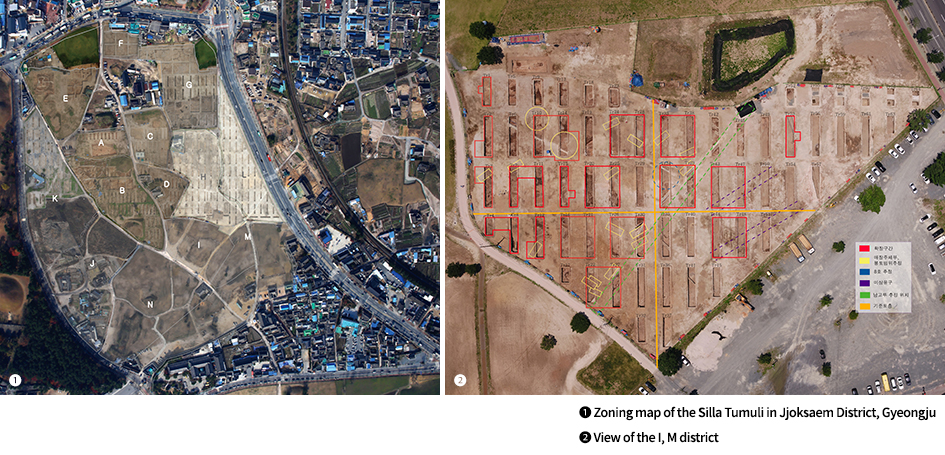

The Silla Tumuli in Jjoksaem District, Gyeongju is located mostly in Hwango-dong and partially in Hwangnamdong and Inwang-dong, Gyeongju. Originally, excavations were supposed to involve a total area of 384,000 m2. However, due to limitations surrounding land purchases and budgets, the area was reduced to 229,674m². Since excavations must be conducted across a large area, the Jjoksaem site was divided, based on small paths within the site, into 14 zones ranging from A to N. Thus far, excavations of Zones A, B, C, D, E, F, G, H, I, L, and M have been completed, and these excavations have identified some 1,000 Silla tumuli of diverse types, including wooden chamber tombs covered by stone and earthen mound, wooden chamber tombs, and stonelined tombs. Recent achievements from the archaeological investigation of the Jjoksaem site are described below.
Tumuli Distribution Survey of Zones I and M of the Jjoksaem SiteLocated in the southeastern part of the site, Zones I and M sit next to each other in the east-west direction, and their combined area totals 11,008 m². A tumuli distribution survey of these zones has identified a total of 146 tombs from the Three Kingdoms period, including Tomb No. 8 discovered during the Japanese colonial period, 6 wooden chamber tombs covered by stone and earthen mound, 131 wooden chamber tombs, 3 stone-lined tombs, and 5 jar burials.
As for wooden chamber tombs covered by stone and earthen mound identified in Zones I and M, only parts of their circular burial protection stones and burial chambers remain, without any traces of the earthen mounds as they failed to stand the test of time. In particular, compared with other zones, for the same unit area, Zones I and M have the least number of wooden chamber tombs covered by stone and earthen mound, and these tombs are all small ones with a diameter of less than 10 m. In contrast, the two zones are home to the most number of wooden chamber tombs, among which many are small tombs (with a diameter of 3-4m) featuring only a main chamber Just as in wooden chamber tombs covered by stone and earthen mound, these wooden chamber tombs have lost all their earthen mounds due to construction activity in the area over the years.
As previously mentioned, Zones I and M possess very few wooden chamber tombs covered by stone and earthen mound, the type of tombs used by the upper class. Moreover, even wooden chamber tombs in these zones are small tombs without accessory chambers. These facts suggest that the area served as a cemetery for people of relatively lower social position.
In Zone M, on the other hand, a building feature and road remains from the Unified Silla period, as well as a defensive embankment from the Goryeo period known as namgoru, have been identified. The findings suggest that the area has long been used for a wide range of purposes.
Excavation of Tomb No. 44Located in Zone E, Tomb No. 44 is an aboveground-type wooden chamber tomb covered by stone and earthen mound, measuring 30 m long and 23 m wide. This excavation was the largest one conducted on this type of tomb since the excavations conducted on Cheonmachong Tomb and Hwangnamdaechong Tomb many decades before. This was also the first time a stone mound of this type of tomb was fully exposed for investigation.
Tomb No. 44 mainly consists of circular burial protection stones surrounding the mound the mound; a wooden chamber containing the deceased and burial goods, a stone mound covering the top and four sides of the chamber, and an earthen mound on top of this stone mound. Except for the western side that was lost due to the vicissitudes of history, the entire structure has survived relatively intact, with its distinctive features remaining prominent.
A recent excavation of Tomb No. 44 has revealed a pea gravel layer neatly formed outside the boundary of the circular burial protection stones. On top of this layer, some 110 pieces of varying earthenware used for ancestral rituals were discovered, drawing widespread attention. To the north of the circular burial protection stones, 9 large jars were placed at regular intervals on the pea gravel layer. Within and around these jars, varying types of stoneware vessels (e.g. pedestalled-dish, flat cup with cover) were found. In particular, a long-necked jar with line-carved design was discovered between Large Jar Nos. 3 and 4. The overall design was confirmed to be the depiction of a procession. This newly found long-necked jar with line-carved design features diverse motifs. Specifically, its neck and body feature a series of recurring geometrical patterns, whereas its shoulder features carved drawings of an equestrian procession, dancers, and a hunting scene. This composite layout is the only one of its kind in Silla‘s fine art. In particular, carvings depicting dancers and a hunting scene resemble Koguryo (Goguryeo) wall paintings in terms of composition, which makes them an important resource in studying the relationship between Silla and Koguryo (Goguryeo).
As seen above, a wide array of earthenware used for memorial services were discovered at the site, and the discovery partially revealed the type and content of the memorial rituals conducted near the tomb’s circular burial protection stones, as well as the fact that, even after a tomb’s completion, Silla society at the time continued to maintain the site and perform memorial services there.
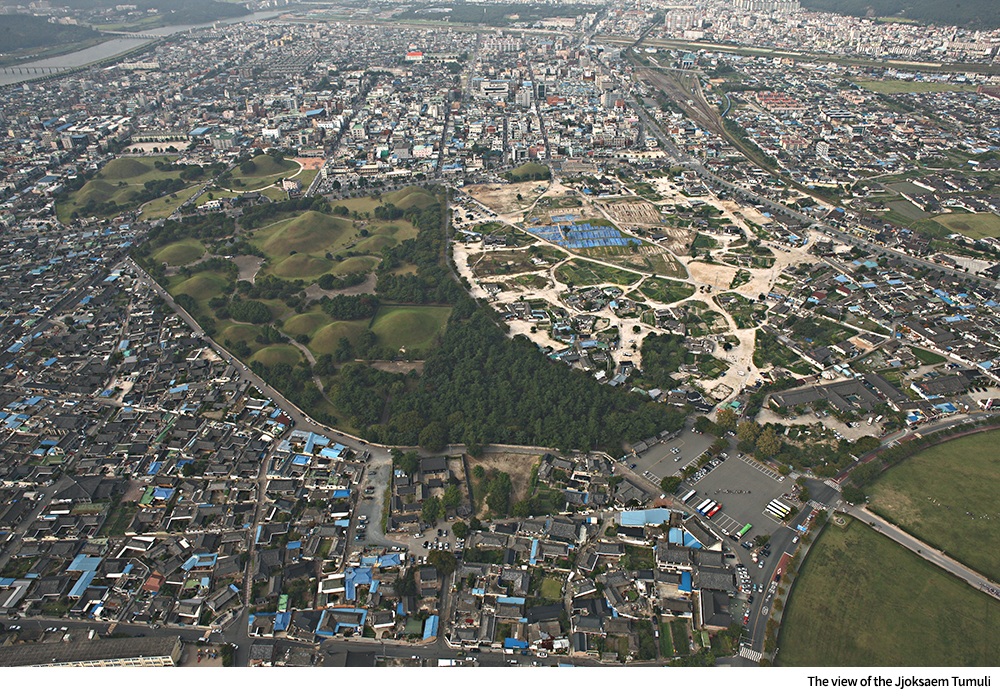

Research on Horse Armor Recovered from Jjoksaem Tomb No. C10In 2009, during an excavation conducted on an wooden chamber tomb named as Jjoksaem Tomb No. C10, a full set of horse armor was discovered, surprising the world. At the time of the discovery, it was found lying in the east–west direction at the chamber floor, with parts covering a horse’s neck, chest, body, and hips all intact. In addition, a bit, a saddle, stirrups, and other diverse harness fittings were unearthed that can serve as important resources in the study of Silla’s equestrian culture.
During the excavation, to better protect some 740 pieces constituting the horse armor, the excavation team even built a provisional facility, where proper temperature and humidity levels could be maintained and pollutants avoided. Furthermore, to safely collect and relocate the horse armor, researchers performed simulation experiments using soil similar, in terms of chemical composition, to the kind found at the site. Based on these experiments, they managed to perfectly cut and transport some 28 tons of soil containing the horse armor and other artifacts. Through conservation science research, our experts were also able to figure out the types of fabric (i.e. silk and hemp) that were attached to the surface of horse armor pieces. Similarly, based on the remaining traces of wood on the horse armor, they discovered that the chamber was probably made of pinewood.
After preservation treatment for the horse armor was completed recently, the institute began research on how its pieces were put together and how it was fitted on horses. To test how the armor affected the movement and mobility of a horse, the researchers created plastic replicas of the armor pieces to create simulated sample armor, and fitted it on a Halla horse (a horse breed from Korea’s Jeju Island). Based on this experiment, the researchers restored the entire set, from the horse armor and chamfron to other related parts, and also analyzed and verified the joining methods of armor pieces and the way the armor was fitted on a horse. The replica and analysis outcomes are expected to be utilized in the future study of Silla’s horse barding culture.
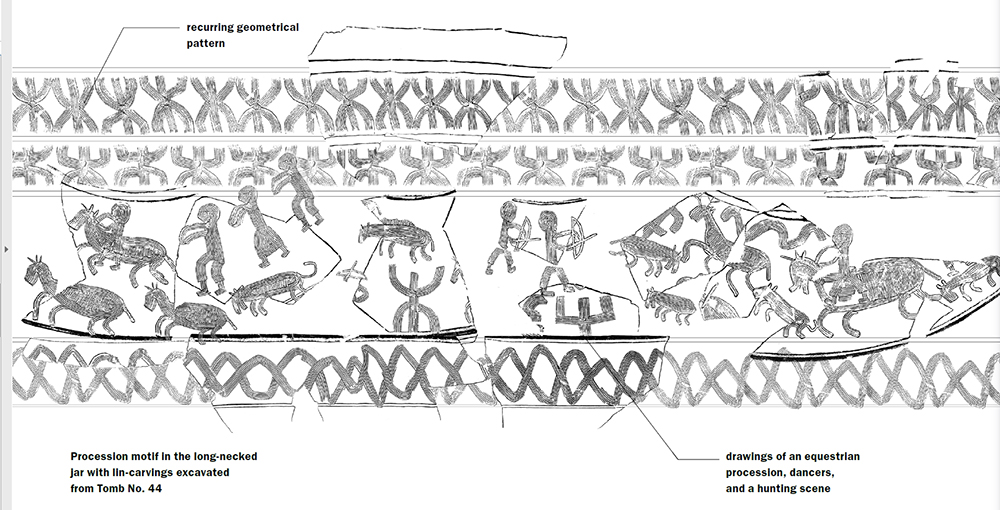

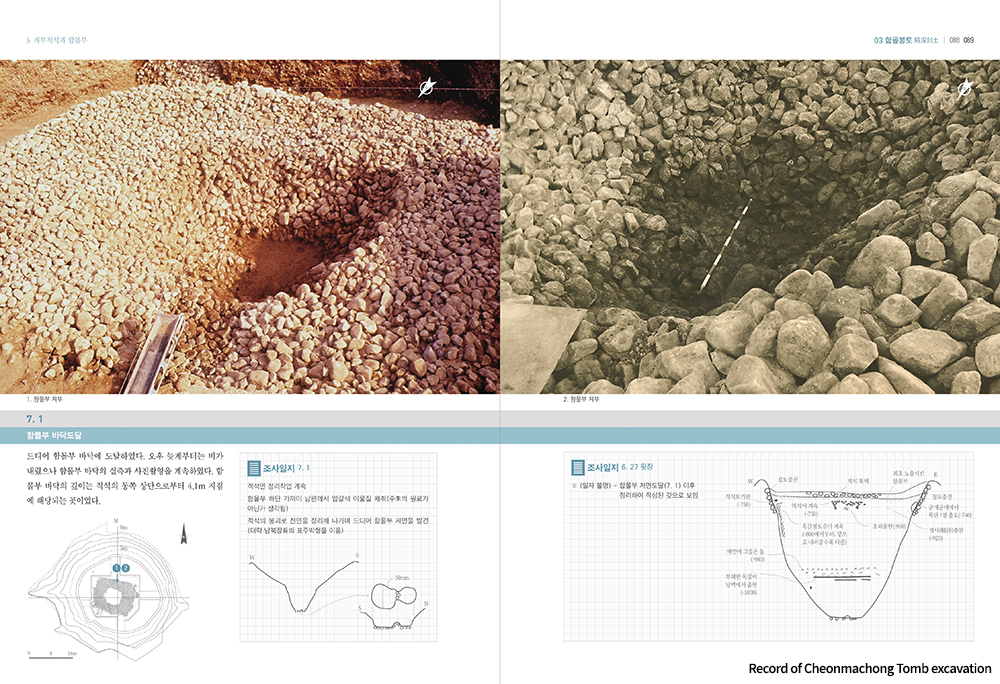

Publication of a Collection of Resources on Silla TumuliRecently, the institution has been working on collecting and reorganizing resources on Silla tumuli, as a way to review relevant archaeological surveys conducted over the years. The first result of this effort was the publication of Cheonmachong Tomb: A Record of Its Archaeological Surveys (Korean title: Cheonmachong, balguljosaui girok) in 2019.
This book is a reorganized collection of research records on Cheonmachong Tomb, which has occupied, since its excavation in 1973, an important place in the archaeological research on Silla tumuli. In addition to providing researchers with a thorough foundation of basic resources, the book makes information on the entire excavation process of the tomb easily accessible to the general public. Data collection and reorganization process conducted by the institute proceeded in the order of data collection, computerization, analysis of content and resources, and issuing of publications. 1,304 photos, 154 survey drawings, and 1,059 documentary records (e.g. field books and daily survey logs) were analyzed for this project. At the same time, to enhance the accuracy of the resource analysis, raw data were also compared and verified with Excavation Report on Cheonmachong Tomb, published in 1974.
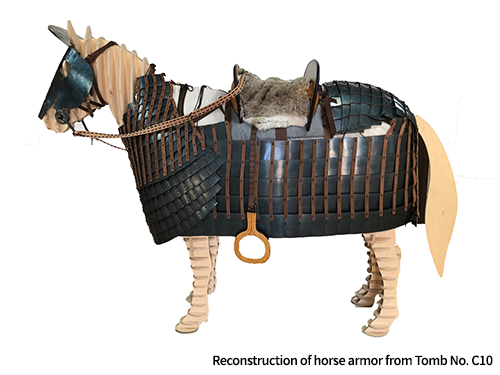

Resources missing and not mentioned in previous reports were collected and organized, and errors and ambiguities from some content were also corrected and clarified also during this process. Furthermore, the collected resources were integrated into a database to facilitate their utilization in future research on Silla tumuli.
Moving forward, the GNRICH will continue to collect and systematize resources on Silla tumuli, through the analysis and digitalization of these resources. At the same time, we will publicly release previously inaccessible resources gathered from previous archaeological surveys, establish a database on Silla tumuli excavation resources, and carry out diverse projects based on insights from the database.

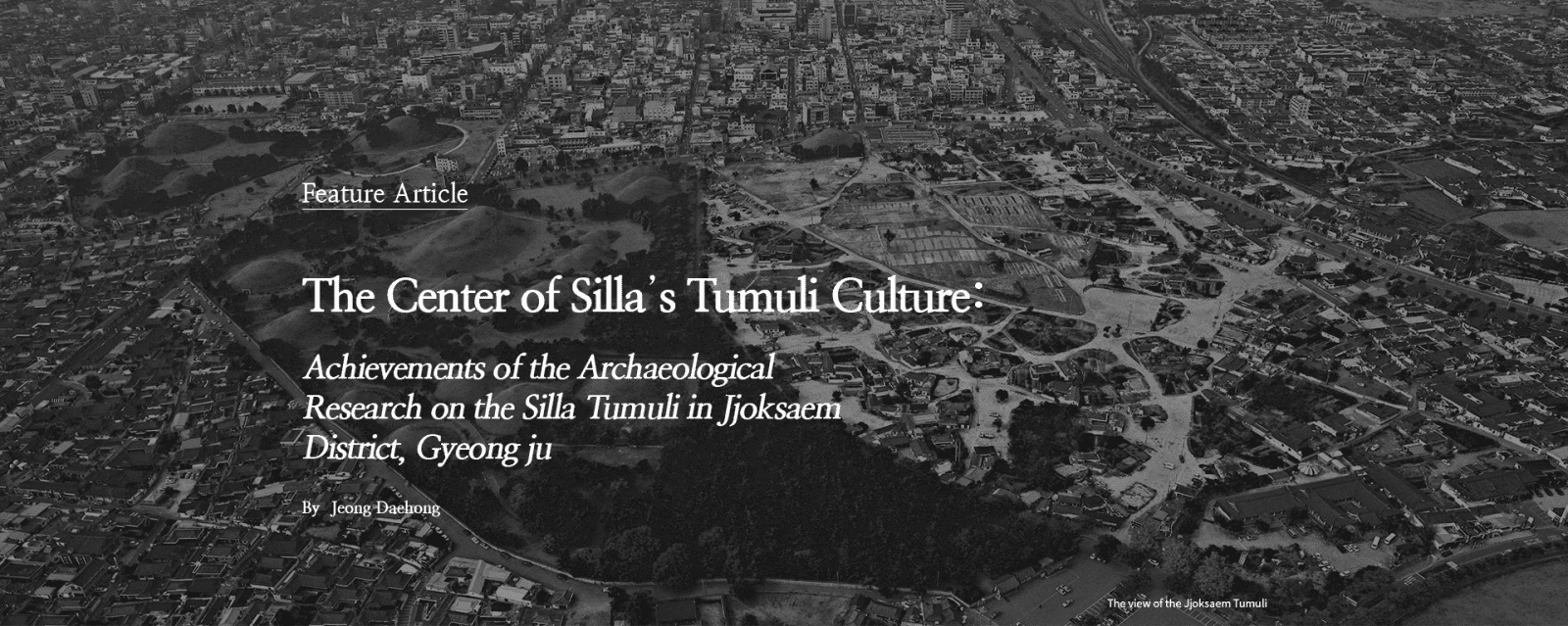
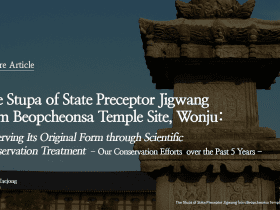
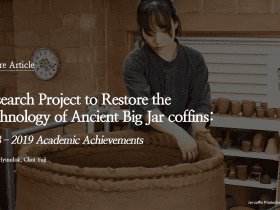

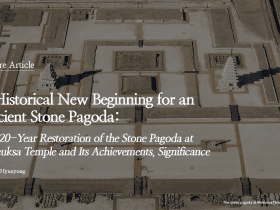
Leave a Reply